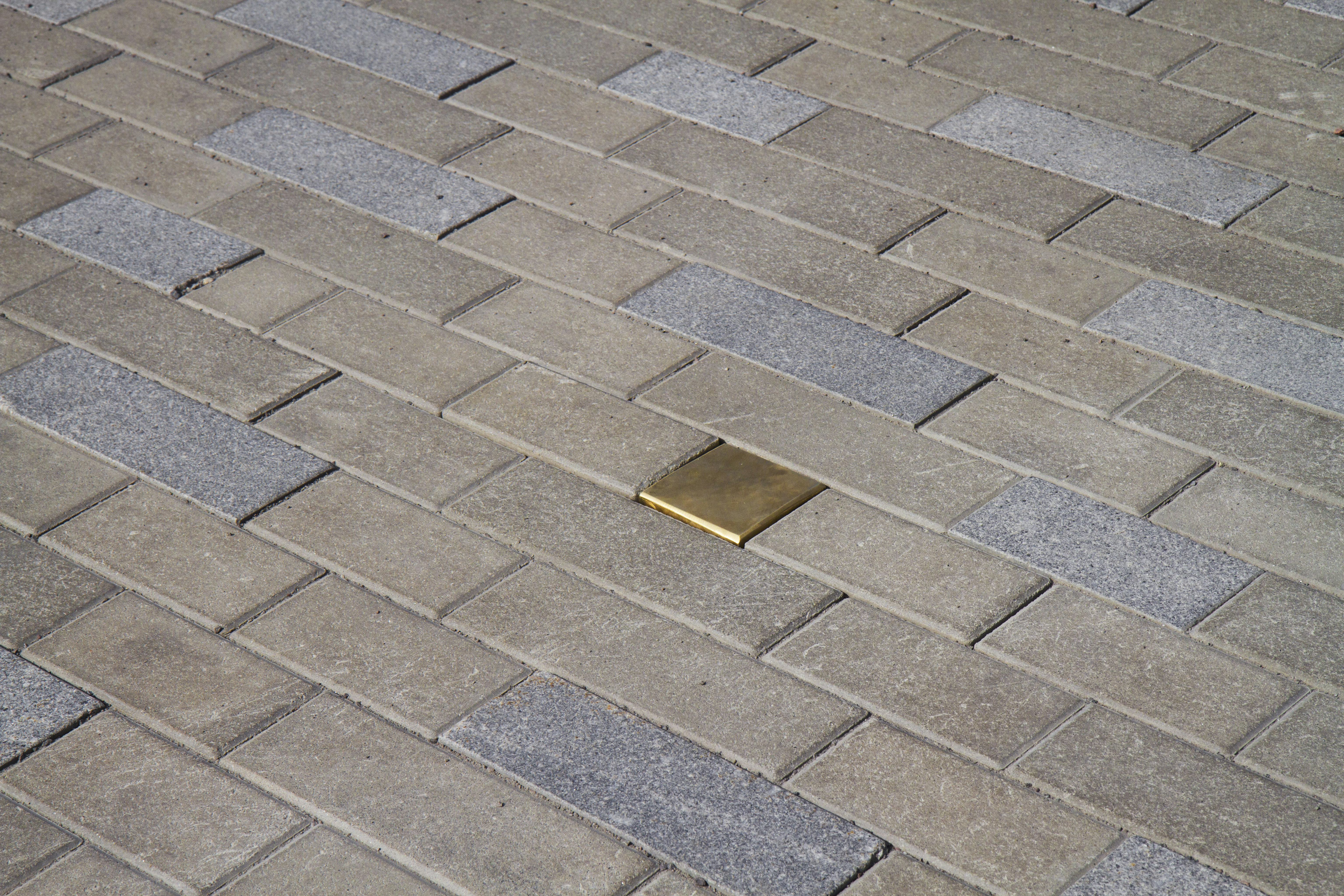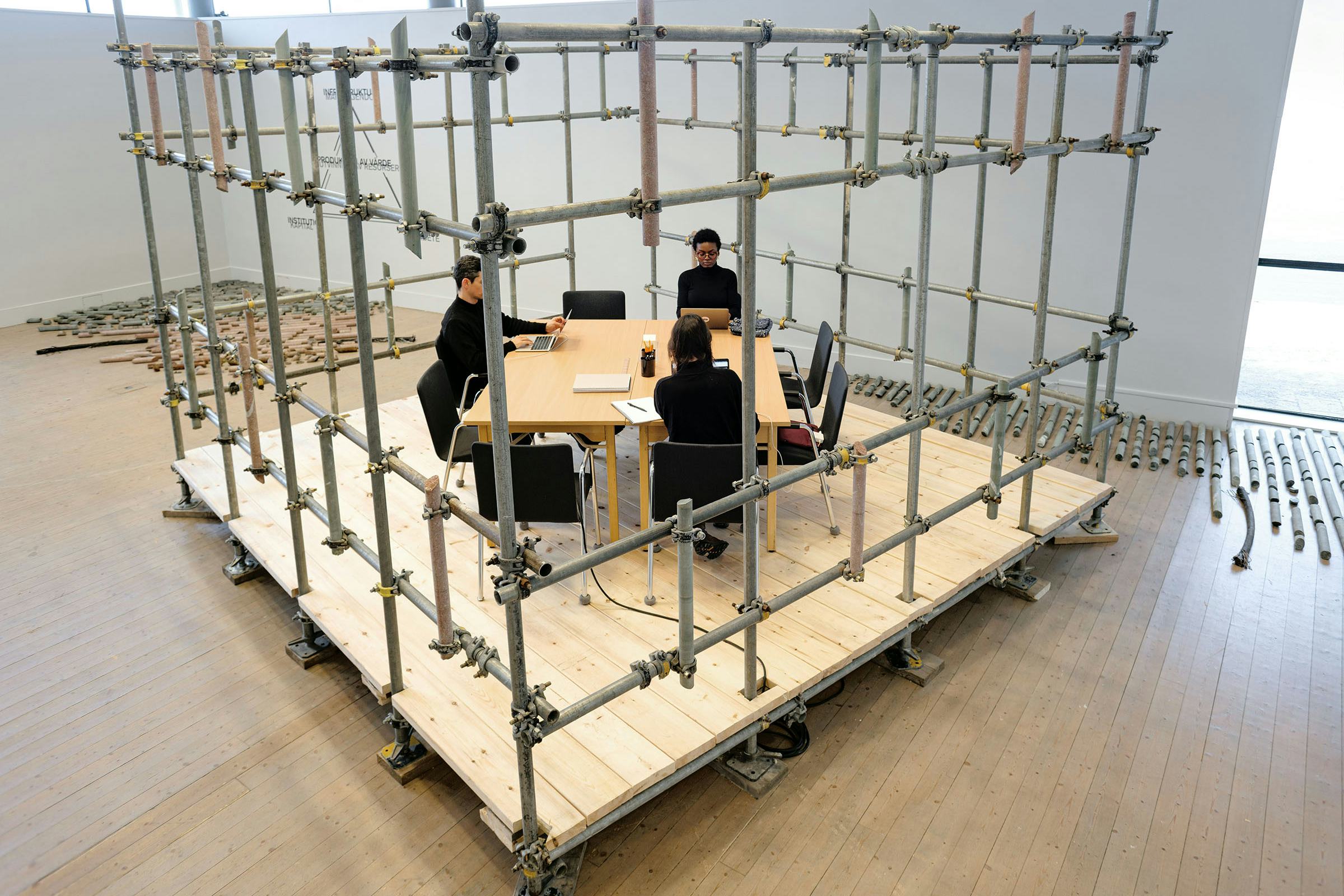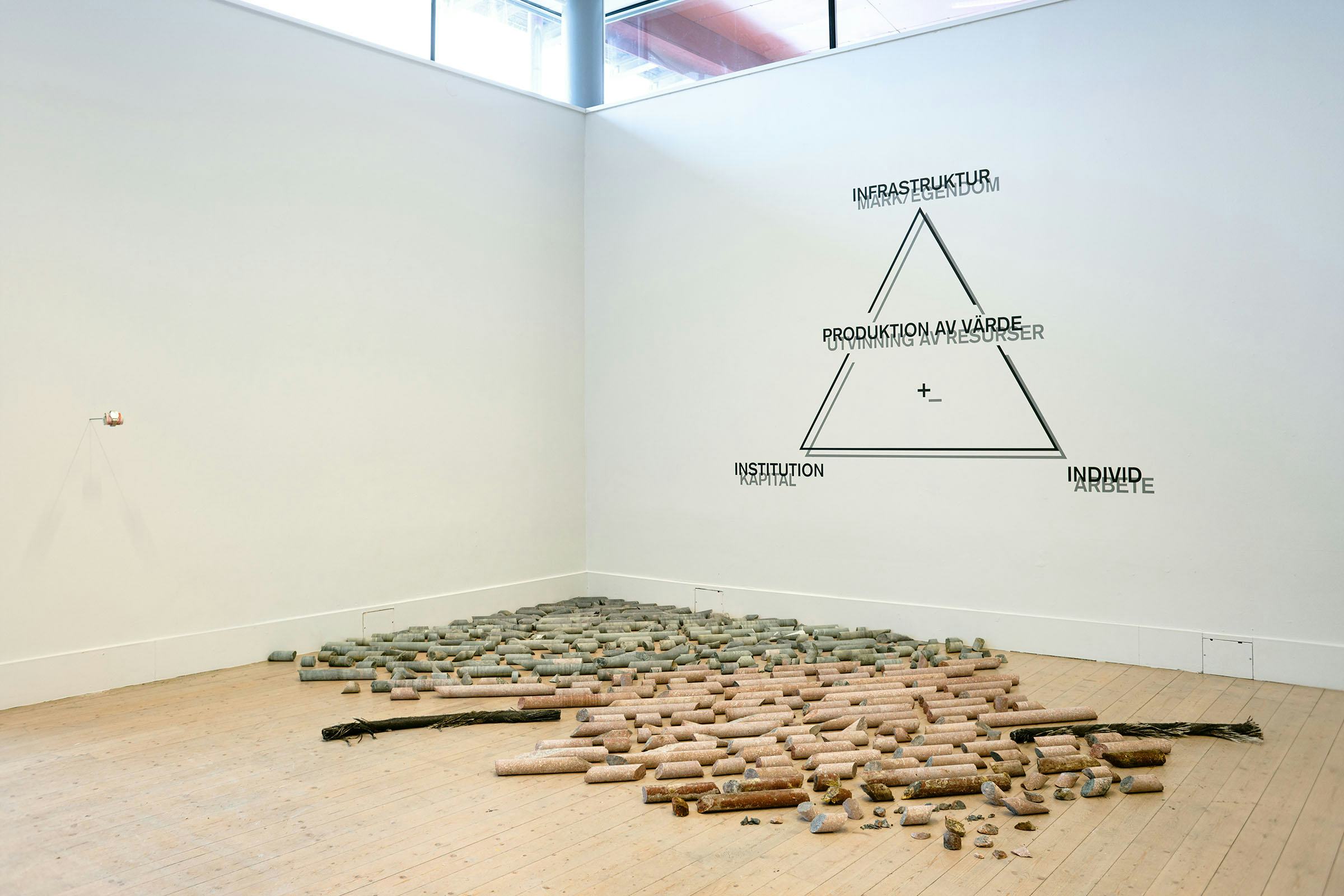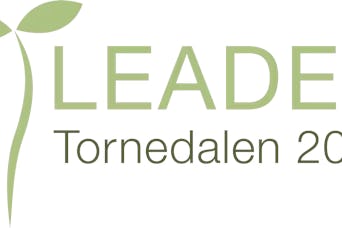LB°22 — Participants
ARKIVDaniel de Paula (b. 1987, Brazil) reflects upon the production of space as the reproduction of dominant abstract ideologies.
Through a posture that is not constrained to the artistic field, his practice is intersected by notions of human and physical geography, revealing his interest in understanding the complex social, political, economic, and historical forces concealed within our surrounding material reality.
On view in Kiruna's public space
combustion / production, 2024
negotiation; a permanent metallic pavement stone placed in the new city centre of Kiruna, Sweden, created from the fusion of metals from three distinct sources: the LKAB iron ore mine; the Mariakapellet crematorium; and the city hall’s clock tower.
Commissioned by Luleåbiennalen 2024.
combustion / production is a site-specific work developed for Kiruna, consisting of a metallic pavement stone cast from three different metals and permanently installed in the town’s new city centre. One metal derives from the iron ore mine in Kiruna, operated by the mining company LKAB. Another metal belongs to the clock hands of the town’s iconic clock tower. And the third derives from metallic leftovers from the cremation of deceased bodies in Swedish crematoriums, which are recovered by companies that recycle and reintroduce these metals into market circulation.
Iron ore extraction is at the core of Kiruna, as the town revolves around one of the world's largest underground iron ore mines. Since the mine's establishment in the late 19th century, it has been the driving force behind Kiruna's development, infrastructure, employment, and community life. However, relentless extraction has caused ground subsidence, leading to the gradual sinking of buildings. This has led Kiruna into one of the world's most ambitious urban relocation projects, with the entire town centre being moved 3 kilometres to the east. Some buildings are being transported to the new site, while others are demolished and rebuilt.
The city’s relocation has not only been a technical and design challenge but also one in regards to the preservation of the intangible qualities, identity and community bonds. A crucial element relocated from the old city centre to the new one is Kiruna’s iconic clock tower, which originally stood atop the first city hall opened in 1963. While the city hall building was demolished, its clock tower, created by sculptor Bror Marklund, was preserved and reinstalled next to Kiruna’s new city hall in the newly developing city centre. This clock tower, a symbol of Kiruna's identity, continues to communicate the town’s public time as an element which connects the old centre to the new, the city’s present to its past.
The urban relocation has also raised ethical challenges. One of the most sensitive cases is the Mariakapell with its columbarium, crematorium and a memorial grove with around 5000 human remains, nearly as many remains as there are living individuals who need to be relocated. After cremation, metal objects such as dental fillings, joint implants, and others are collected by specific companies, recycled, and reused for various purposes, including manufacturing new products or incorporating them into industrial processes. In Sweden, profits from metal recycling support the Allmänna arvsfonden (Swedish Inheritance Fund), which funds social welfare programs, healthcare, research, and cultural projects.
combustion / production combines these distinct metals into a pavement stone resembling the many others paving the streets. The anonymity of the piece within public space contrasts with the ambitious correlations of the materials within it and the stories and processes they represent. The work condenses different time scales, from the millennia-old geological processes of ore formation, the rapid pace of resource extraction, the cyclical rhythm of public time represented by the clock tower, and finally, the span of a human life. In a context where extractive processes have surpassed geological time and the Earth’s limits, exceeded the pace of the city’s development, and exhausted human bodies both within and beyond their life-span – even in death, bodies are "mined" for valuable metals – the work points to the entanglement of human and natural processes and the cycles of life, death, and potential rebirth in Kiruna and beyond. The subtle presence of the floor piece in Kiruna’s newly built public space points to the omnipresence of wider such abstract ideologies and processes that are inseparable from the physical constitution of our built environments, consequently shaping our daily lives.
combustion / production is shown as part of Luleåbiennalen 2024 through the project I Händelsernas Centrum, where experiences are created and provide concrete examples of how culture and art impact our living environments, experiences of places, and our well-being amidst ongoing and imminent changes. I Händelsernas Centrum is co-funded by the European Union and carried out with support from the Swedish Board of Agriculture, and Leader Tornedalen, LKAB and Kiruna kommun.
On view in Konsthallen Kulturens Hus, Luleå
form, 2017 – ongoing
negotiation; rock cores resulting from geotechnical surveys carried out in Norrbotten for the assessment of mineral deposits, scaffolding, displacement of the institution’s office furniture to the exhibition space, workforce of Konsthallen Kulturens Hus, sections of the SEA-ME-WE3 telecommunications’ cable
The scaffolding in the exhibition space is a context-specific work by Daniel de Paula titled form, and creates a temporary working space for the staff of Luleå Konsthall. This space, equivalent in area to the two offices where the team normally works, will be utilised for staff meetings and gatherings with the public during the exhibition period. By bringing the processes of institutional conversation and decision-making into the public limelight, the installation not only transforms the exhibition space into a functional working area but also blurs the boundaries between private spaces of decision-making and those intended for public presentation.
In addition to the standard components of the scaffolding, the artist incorporates rock cylinders into the structure, known as drill core samples. These types of rock samples are commonly extracted from the Earth's subsurface through geotechnical drillings to analyse the geological characteristics of a certain area. The pieces consist of layers of rock sedimented over millennia, containing valuable information on mineral composition and geological processes. The exhibited core samples were extracted in Norrbotten to assess the feasibility and profitability of future copper mining in the region.
Copper has a multifaceted importance in today’s society, as its conductivity makes it indispensable for many electrical components and renewable energy technologies. It is one of the essential components of data cables, one of today’s most important technological infrastructures. The work form includes sections of the SEA-ME-WE3 telecommunications cable, the world's longest at a length of 39,000 kilometres, linking North Germany to Australia and Japan. Cables such as this have an increasingly significant impact in Norrbotten, as the region is emerging as a vital hub for data centres. Norrbotten's favourable conditions, including a cold climate and abundant, affordable renewable energy sources, make it an attractive destination for data centre operators, with companies like Facebook already established in the region.
Both the rock core samples and the data cables are transmitters of information, the first holding tangible records of the Earth's geological history, and the latter facilitating the global communication and exchange of data. Both also open potential avenues for resource extraction, from tangible mineral resources to immaterial data. The displacement of the institution’s workforce to the exhibition space and their direct coexistence with these elements, emphasise the interconnectedness of (art) institutions with these and other external world-shaping processes. This invites a reflection on the relations between tangible and immaterial processes, between geological processes spanning millennia, the global flow of data optimised in seconds, and the rhythms of our daily work and lives, unfolding within the human life-span.
PRODUCTION OF VALUE / EXTRACTION OF RESOURCES (from the series anti-epifania), 2024
negotiation; liquitex acrylic and corpse scent utilised for training dogs for the detection of bodies by emergency teams in contexts of infrastructural disasters on museum wall
abstract time, 2019 – on-going
dead worker’s wristwatch functioning counter-clockwise and cash equivalent to monthly minimum wage of a miner in Sweden. 6,5 × 4 × 33 cm
In correlation to the installation intertwining scaffolding, rock core samples, data cables and institutional labour, Daniel de Paula presents an adapted version of his work abstract-time and the wall painting PRODUCTION OF VALUE / EXTRACTION OF RESOURCES.
The work abstract-time consists of a wristwatch which belonged to a deceased mine-worker. The artist altered the movement of its pointers making them run counter-clockwise, while its wristband holds an amount of cash equivalent to the monthly minimum wage of a miner in the region.
The wall painting presents a diagrammatic and textual correlation between the concepts of individual, institution, and infrastructure. Here the painted words and their respective shadows create dissonances of meaning. The paint utilised by the artist is infused with the scent of dead bodies, commonly used in the training of dogs for the detection of corpses in contexts of infrastructural disasters. This subtle scent is known to be perceptible to certain animals but undetectable to the human nose.
These two works expand the artists’ reflection on the connections between the concepts of “time” and “work”, ranging from human life-span to geological eras, and from individual labour to wider structures of capitalism. As well as their connections to institutional and individual agency towards wider world-shaping processes, such as resource extraction and circulation. They also resonate with combustion / production, a new site-specific artwork the artist developed in the town of Kiruna. combustion / production consists of a pavement stone composed of three distinct metals. Part of them come from the world's largest iron ore mine in Kiruna, operated by LKAB, a Swedish state-owned mining company. The other metal comes from the clock pointers of the clock tower of Kiruna’s first City Hall, which has been displaced and installed in the town’s new city centre. The third material is recovered metal from the process of cremation of corpses in Swedish crematoriums, recuperated and recycled by companies that reintroduce them in market circulation, generating profits that are directed to the Swedish pension system. The three different metals are melted and cast into a pavement stone that will be installed in Kiruna’s public space during the closing of Luleåbiennalen 2024 and inhabit the new city centre for posterity.
Daniel de Paula holds a BFA in visual art from Fundação Armando Alvares Penteado in São Paulo and also studied astrophysics and human geography. The artist and researcher has had solo exhibitions at Galeria Jaqueline Martins, BR (2023), LABOR Gallery, MX (2023), Galleria Francesca Minini, IT (2020), and Kunsthal Gent, BE (2019), and took part in group exhibitions such as the Biennale de Lyon, FR, São Paulo Bienal, BR, The Renaissance Society, and Padiglione d’Arte Contemporanea, IT.
Supported by
The European Union
Leader Tornedalen
The Swedish Board of Agriculture
Mondriaan Fund
JIAB Ställningsmontage
SSAB
Oceanic Environmental Cables GmHb
Swerim
Händelsernas Centrum (The Center of Events)
Part of the artist's contributions to the Luleå Biennial 2024 was created as part of Händelsernas Centrum: a project which creates art experiences that contribute concrete examples of how culture and art affect our living environments, experiences of places and our moods during ongoing and imminent changes. Händelsernas Centrum is co-funded by the European Union and carried out with support from the Swedish Board of Agriculture, and Leader Tornedalen 2030, LKAB and Kiruna kommun.



